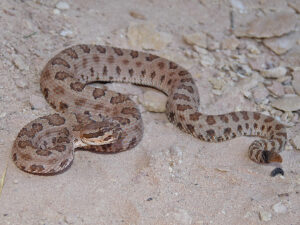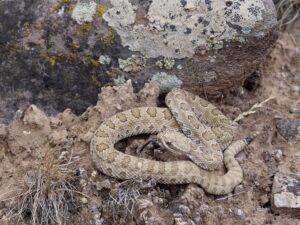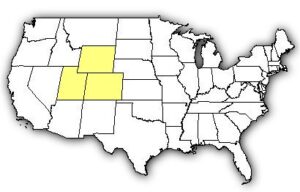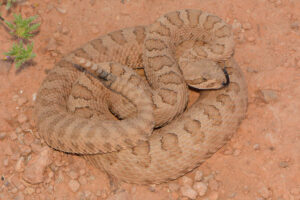The midget faded rattlesnake or faded rattlesnake is a pit viper species of the western United States. It is a small, nocturnal, and crepuscular snake with a faded color pattern that helps it camouflage as a means of defense from predators and aids in foraging.
Scientific Classifications
- Suborder:Serpentes
- Family:Viperidae
- Genus:Crotalus
- Species:C. concolor
Conservation Status
Description
Size
Typically, adults are of the size 24 in (60.96 cm). The serpent grows to a maximum length of 29.5 in (75 cm), with the smallest recorded length being 20.5 in (52.2 cm). The males are larger than the females.
Color and Appearance
The ground color is pale brown, straw-colored, pinkish, reddish, or yellow-brown, overlaid with a series of brown rectangular or elliptical dorsal blotches. However, most individuals are silvery pr gray. The juveniles have a distinct pattern that fades as they grow into adults, almost to the point that it becomes indistinguishable from the ground color. The eyes are hooded with an extra scale and have elliptical pupils.
Are They Dangerous to Humans
The peaceful snake acts defensively only when spooked or disturbed. Then it assumes a defensive posture by picking its head off the ground. It also rattles its tail like other rattlesnakes to alert and ward off its predator. It always tries to flee from an encounter whenever possible, but if it feels threatened enough, it strikes.
The faded rattlesnake has the most toxic venom of all Crotalus species though there is considerable variation among the local populations. The venom is also the most potent in North America. Going by the LD50 value, it is many times stronger than the Asiatic cobra due to the presence of a presynaptic neurotoxin called the concolor toxin, the amount of which varies among individuals. This, in combination with a potent myotoxin, makes the venom deadly. So, a bite victim needs to be immediately hospitalized. The symptoms of envenomation include swelling, blistering, intense pain, nausea, and vomiting.
Midget Faded Rattlesnakes at a Glance
Distribution
It lives in the US, in the Green River and Colorado river basins. The range covers Utah (east of 111° West longitude, excluding the southeastern corner), southwestern Wyoming, and extreme west-central Colorado.
Habitat
It occupies rocky, cliffy habitats near rivers and their tributaries. It also lives in high, cold deserts (below 7000 ft elevation) dominated by sagebrush and exposed canyon walls.
Lifespan
The midget faded rattlesnake lives for up to 25 years.
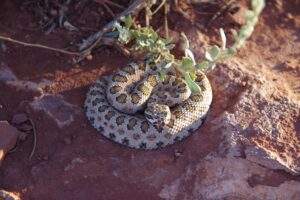
Predators
It is preyed upon by hawks, owls, kingsnakes, and coyotes.
Diet
It mainly feeds on lizards but also takes small mammals and birds.
Reproduction
Ovoviviparous (gives birth to live young from eggs that hatch inside the body)
The rattlesnake breeds after emerging from hibernation in early May. The young are born between mid-August and September. Typically a litter consists of 3-4 offspring. Triennial breeding (every 3 years) is most common, but they also breed biennially and quadrennially.
Source
pinglelist.org, coloradosnakes.com, venombyte.com, thehibbitts.net, nps.gov

